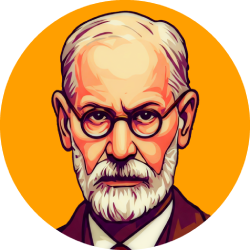Hello, I am João Barros, psychoanalyst and writer, and I am here to explore with you one of the most fascinating themes of psychoanalysis: the idea that, beyond the pleasure principle, there is a force that leads us to seek the opposite, repetition and ultimately death. This may seem dark, but it is a fundamental concept to better understand ourselves and our behaviors.
Introduction to the Pleasure Principle
Before diving into the darkest waters of psychoanalysis, let’s start with the basics. The pleasure principle is a central idea in Sigmund Freud’s theory, suggesting that human beings are motivated to seek pleasure and avoid pain. That seems logical, isn’t it? Who doesn’t like to feel good and avoid unpleasant situations?
However, real life gives us many situations where people seem to act against their own interests, seeking pain or repeating patterns that are clearly not beneficial. This is where the idea of ”beyond the pleasure principle” comes in, a concept that Freud explored in his 1920 work.
The death drive
One of the main contributions of “Beyond the Pleasure Principle” is the introduction of the death drive, or “Todestieb” in German. This force is seen as an innate tendency in living beings to return to a state of inorganicity, that is, to death. This may seem a little weird, but think about it: often our self -destructive or repetitive behaviors can be seen as a way of seeking a kind of symbolic “death”, an escape from the tension and stress of life.
This drive is not necessarily about wanting to die, but more about a search for a state of calm, peace, which is often confused with the idea of death. It is as if, in our most difficult times, a part of us longed for an end to pain and suffering, even if it means the end of life itself.
Compulsive repetition
Another crucial concept in “Beyond the Pleasure Principle” is compulsive repetition. Have you noticed how people tend to repeat behavioral patterns, even when these standards are clearly harmful? This can range from toxic relationships to self -destructive habits, and everything else we can imagine.
The idea behind the compulsive repetition is that somehow we are trying to resolve or overcome unresolved trauma or conflicts from the past. Each repetition is an attempt to rewrite the script, to do things differently, but for some reason we end up trapped in the same cycle.
This search to solve the past through repetition can be seen as a way of seeking control in situations that originally left us without control. It is a complex mechanism that involves both life drive and death drive, because while we try to overcome and live, we are also, in a way, seeking a form of “death” to our present self.
Implications in everyday life
Now you may be wondering how these abstract concepts apply to your daily life. Well, the truth is that they are more present than you think. From that relationship you can’t leave, even knowing it’s not healthy, even that habit you try to change, but it ends up repeating, it is all related to the death drive and compulsive repetition.
Understanding these concepts can be liberating. Recognizing that our self -destructive or repetitive behaviors can have deeper roots than simply a lack of willpower can lead us to approach these problems differently. Instead of just trying to stop behavior, we can start exploring what is behind it, what are the unresolved traumas or desires that are leading us to repeat these standards.
This does not mean it will be easy. Working with these deep forces within us is a challenging and often painful process. However, it is a necessary step towards personal growth and to overcome self -destructive cycles that can arrest us for years.
So the next time you catch yourself repeating a pattern you don’t want, or feel attracted to something you know is not good for you, remember that there may be more at stake than just a conscious choice. It may be a sign that it is time to explore more deeply what is happening within you, and perhaps, perhaps, to find a way beyond repetition and pain.


